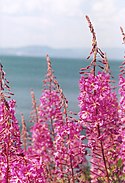Cirkumboreální oblast
Cirkumboreální oblast ve fytogeografii je floristický region uvnitř boreální říše v Eurasii a Severní Americe, jak ji vymezili geobotanikové jako byli Josias Braun-Blanquet a Armen Tachtadžjan.
Je to největší floristická oblast na světě podle plochy, zahrnující většinu Kanady, Aljašky, Evropy, Kavkazu a Ruska, jakož i Severní Anatolie (jako nejjižnější část oblasti) a ze Spojených států amerických části severní Nové Anglie, Michiganu a Minnesoty. Severní části regionu zahrnují polární poušť, tajgu[1] a tundru. Mnoho geobotaniků rozděluje euroasijské a severoamerické oblasti na dva odlišné oblasti. Kontinenty však sdílejí velkou část své boreální flóry (např. bříza zakrslá, olše zelená, brusnice brusinka, medvědice lékařská). Flóra byla zásadně ochuzena během glaciálu v pleistocénu. Cirkumboreální oblast je ohraničena Východoasijskou, Atlanticko-severoamerickou oblastí, Oblastí Skalistých hor, Středozemní a Íránsko-turanská oblastí.
Neexistují žádné rostlinné čeledi endemické pro tuto oblast, ale má endemické rody (např. měsíčnice, Borodinia, Gorodkovia, Redowskia, dřípatka, Physospermum, jarmanka, Thorella, plicník, nemléč, Ramonda, Haberlea, Jankaea, řezan, kolotočník) a mnoho endemických druhů, zejména na horách.
Floristické provincie
Oblast se dělí do mnoha floristických provincií. Jejich vymezení je diskutabilní. Podle Tachtadžjanovi klasifikace se jedná se o Arktickou, Atlanticko-evropskou, Středoevropskou, Ilyrsko-Balkánskou, Euxinskou, Kavkazskou, Východoevropskou, Severoevropskou, Západosibiřskou, Altajsko-sajanskou, Středosibiřskou, Zabajkalskou, Severovýchodosibiřskou, Ochotsko-kamčatskou a Kanadskou provincii.[2]
Odkazy
Reference
V tomto článku byl použit překlad textu z článku Circumboreal Region na anglické Wikipedii.
- ↑ C.Michael Hogan. 2011
- ↑ Floristické provincie světa | BOTANY.cz [online]. [cit. 2019-11-26]. Dostupné online.
Literatura
- (anglicky) C.Michael Hogan. 2011. Taiga. eds. M.McGinley & C.Cleveland. Encyclopedia of Earth. National Council for Science and the Environment. Washington DC
- (anglicky) David Lewis Lentz. 2000. Imperfect balance: landscape transformations in the Precolumbian Americas, Science, 547 stran
- (anglicky) Robert F. Thorne. Phytogeography of North America North of Mexico. Flora of North America, Vol. 1, Ch. 6.
Média použitá na této stránce
Floristic regions in Europe and western Siberia, according to Wolfgang Frey and Rainer Lösch
- The central european region and the central russian region are sister regions. The border between them is similar to the Fagus sylvatica limit (January, day-time temperature average: above -2°C).
- The border between the central russian region and the boreal region is similar to the Quercus spp. limit (Day-time temperature average: above 10°C, 4 months per year).
- The border between the boreal region and the arctic region is similar to the tree line, taiga/ arctic tundra limit (July, day-time temperature average: above 10°C).
- The border of the atlantic region is the limit of no frost (average), Gulf Stream influence.
- The warm islands in the Atlantic ocean are in the macaronesia region: isolated populations in a more humid environment.
- The mediterranean region is similar to the occurrence of wild Olea europea and wild Cistus salviifolius (Olea europea is grown very North in Italy).
- The border between the submediterranean region and the central european region is similar to the alpine arc (upper Rhone, upper Rhine, lower Danube), a weather barrier.
- The pontic region border is similar to the tree line/ steppe limit (less than 450 mm precipitation per year).
- The turanian region has a semi-arid climate.
- References:
- Frey W, Lösch R (2004) Lehrbuch der Geobotanik. Elsevier, Spektrum; München, Heidelberg; ISBN 3-8274-1193-9 (graphic modified from Walter H (1954) Grundlagen der Pflanzenverbreitung. Einführung in die Pflanzengeographie, II. Teil: Arealkunde. Ulmer, Stuttgart-Ludwigsburg)
- Frey W, Lösch R (2010) Geobotanik: Pflanzen und Vegetation in Raum und Zeit. 3 ed, Spektrum, Heidelberg, ISBN 978-3-8274-2335-1
Autor: Kim Hansen, Licence: CC BY-SA 3.0
Betula nana photographed on a hike north of the village Upernavik Kujalleq and north-east of the mountain Kingigtoq, Greenland.









